Paterson, Alan Gordon
Killed in Flying Accident 1983-01-20
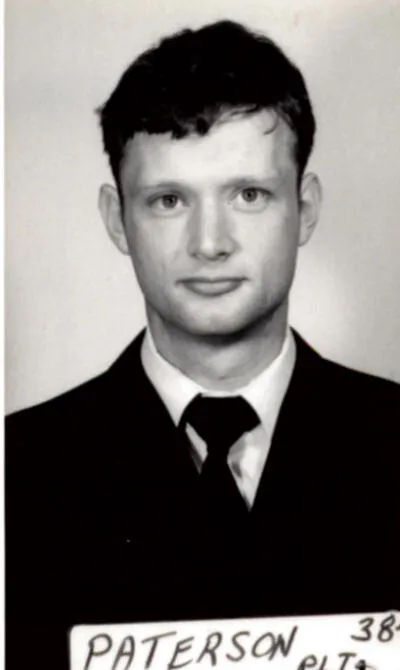

Birth Date: 1955
Born:
Son of George Robert and Iris Joan (nee Stroudley) Paterson of West Vancouver, British Columbia. Brother of Teresa Lindi Bonfiglio.
Home:
Enlistment:
Enlistment Date: Unknown
Service
RCAF
Unit
434 Sqn- Squadron
In Excelsis Vincimus We conquer in the Heights
Base
Rank
Lieutenant
Position
Lieutenant
Service Numbers
N41901060
First Burial
 Canada
Canada
Northrop Freedom Fighter CF-116 CF-116A CF-5 CF-5A CF-5D
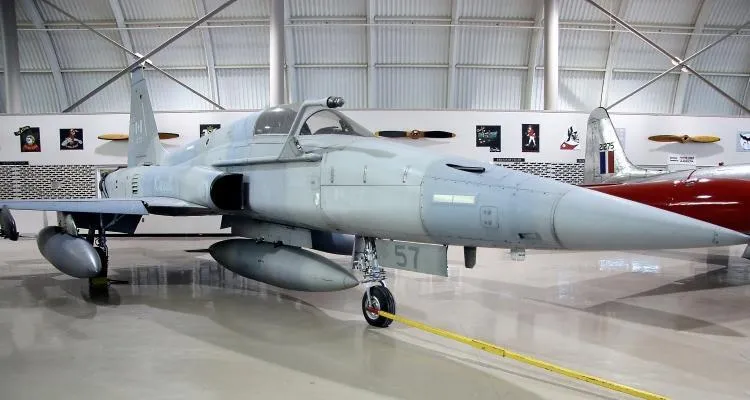
Canadian Warplane Heritage Museum
Northrop Aviation designed the F-5 Freedom Fighter in the mid 1950s to meet an anticipated need for a lightweight, well armed, supersonic fighter that was relatively inexpensive. Initially the USAF was not interested in such an aircraft, but did require a supersonic trainer. It encouraged continued development of a two seat version, which became the T-38 Talon trainer. In May 1958, the US Defense Department reconsidered its position and ordered three prototypes for its Military Assistance Program (MAP). The first prototype flew in July 1959 and exceeded Mach 1 during its first flight. After another three years of development, the F-5 was selected by the Defense Department for the MAP in 1962.In 1965 the RCAF decided to replace its home based North American Canadair Sabres with a new aircraft. The F-5 was chosen and Canadair was selected to manufacture it, with Orenda Ltd. of Toronto building its General Electric J85(GE)-15 turbojet engines. A total of 89 CF-5A fighters and 46 CF-5D trainers were purchased by the Canadian Armed Forces.Production of the CF-5A started in Montreal in 1967 and the first aircraft flew from Edwards AFB, California in May 1968. The first CAF unit to receive aircraft was AETE (Uplands), when both fighter and trainer versions were delivered for testing at the end of 1968. No. 434 "Bluenose" Squadron at CFB Cold Lake, Alberta was equipped with CF-5s soon after in 1969. No. 433 "Porcupine" Squadron, reactivated in September 1969 at CFB Bagotville, was the other squadron to receive CF-5s that year. Later on, both No. 1 FTS (Cold Lake) and No. 419 "Moose" Squadron flew CF-5s in both trainer and tactical fighter roles. The CF-5A continued in service as a tactical fighter until 1988, when the CF-18 Hornet replaced it. The CAF continued to use CF-5Ds as advanced trainers until 1995.A total of 2,350 F-5 Freedom Fighters were produced, between 1962 and 1975; 240 of them by Canadair in Montreal (135 for the CAF and 105 for the Royal Netherlands Air Force).The Museum's CF-5A was built by Canadair in Montreal in 1970. After it was retired from the Canadian Forces in 1989, it was moved to the RCAF Memorial Museum in Trenton, Ontario. Canadian Warplane Heritage Museum acquired the aircraft from the Department of National Defence in 1996..Canadian Warplane Heritage Museum
 CF-116 Freedom Fighter Kestrel Publications
CF-116 Freedom Fighter Kestrel Publications
434 Sqn In Excelsis Vincimus ("Bluenose")
History of the Squadron during World War II (Aircraft: Halifax V, III, Lancaster I, III)
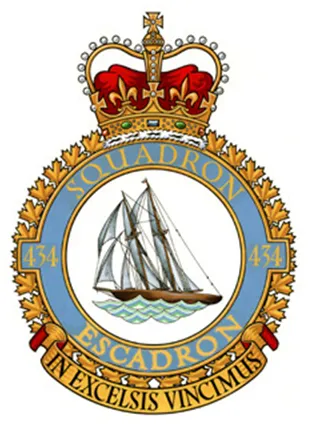
The unit was first formed at RAF Tholthorpe, Yorkshire, UK on 13 June 1943, flying the Handley Page Halifax Mk V aircraft. It was the 31st squadron and the 13th Bomber unit formed overseas. From its initiation it was part of the No 6 (RCAF) Group of RAF Bomber Command. On 13 August 1943 it flew its first operational sortie, a bombing raid across the Alps to Milan, Italy. In May 1944 the unit received Halifax Mk IIIs to replace its Mk Vs. The squadron was adopted by the Rotary Club of Halifax, Nova Scotia and to show its connection to the city adopted the nickname "Bluenose Squadron", the common nickname for people from Nova Scotia and a tribute to the schooner Bluenose; an image of the schooner appears on the squadron badge.
The squadron moved to RAF Croft, Yorkshire in December 1943 and re-equipped with Avro Lancaster Mk Is and Mk Xs in December 1944. After VE Day the squadron was earmarked for the Tiger Force to carry on the war against Japan, but was never deployed to the Far East because of the Japanese surrender. The unit was disbanded at Dartmouth, Nova Scotia on 5 September 1945.
During World War II the unit flew 198 missions, including 179 bombing, 17 mine laying, one diversionary and one sea search. This was made up of a total of 2582 individual aircraft sorties, including 45 prisoner of war airlift sorties. It flew 14,622 operational flying hours and dropped 10,358 tons of bombs plus 225 mines. The squadron accounted for seven enemy aircraft destroyed along with two probable and four damaged. 434 Squadron suffered 75 aircraft lost, 484 aircrew operational casualties, including 34 killed, 313 presumed dead, 121 made prisoners and 16 who evaded capture and escaped. Unit personnel received six bars to the Distinguished Flying Cross, 108 DFCs, six Distinguished Flying Medals, one British Empire Medal and seven Mentions in Despatches. Battle Honours were: English Channel and North Sea 1943-44, Baltic 1943-44, Fortress Europe 1943-44, France and Germany 1944-45, Biscay Ports 1944, Ruhr 1943-45, Berlin 1943-44, German Ports 1944-45, Normandy 1944, Rhine.Wikipedia, Kostenuk &Griffin .
 Squadron History (Bomber Command Museum PDF)
Squadron History (Bomber Command Museum PDF)
Maps for Movements of 434 Squadron 1943-45
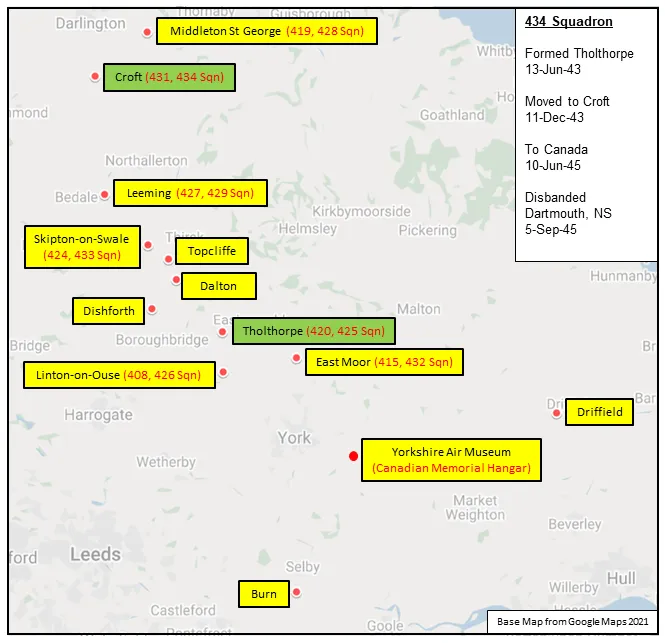
434 Squadron History Summary 1943-45
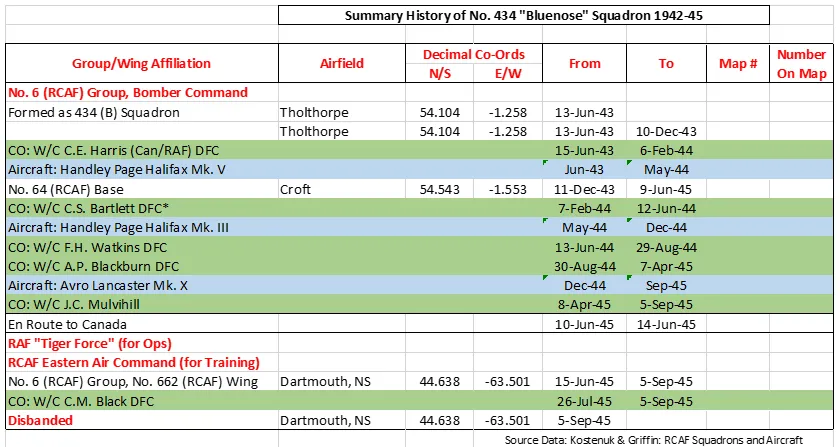
History of the Squadron Post-WWII (Aircraft: Sabre 2, 5, 6, Starfighter, Freedom Fighter, Challenger)
The squadron was re-formed as a fighter unit at Uplands, Ontario on 1 July 1952, flying Canadiar Sabre aircraft. It joined No.3 (Fighter) Wing at Zweibrücken, Germany in March 1953. It was selected to be one of the eight squadrons to be equipped with the CF-104 Starfighter in a Strike Attack role. Accordingly, it was deactivated on 15 January 1963 and reactivated on 8 April. The squadron was deactivated on 1 Mar 1967.
The unit was re-formed as 434 Operational Training Squadron at CFB Cold Lake, Alberta on 15 February 1968 as the operational training unit for the Canadair CF-5 Freedom Fighter. The squadron later gave up its OTU duties to 419 Squadron and became an operational squadron, moving to CFB Bagotville on 15 July 1982, later moving to CFB Chatham in July 1985. It was again disbanded on 17 March 1989. The unit was again re-formed as 434 Composite Squadron at CFB Shearwater on 4 July 1992. The name was changed to 434 Combat Support Squadron and the unit moved to CFB Greenwood in mid-1995, flying the CC-144 Challenger and Canadair CT-133 Silver Star in the electronic warfare role. The squadron was once again disbanded there in May 2000.
The squadron was reactivated in May 2018 at CFB Trenton as a test and evaluation unit. For details see
. Canadian Virtual War Memorial
Canadian Virtual War Memorial Freedom Fighter
Freedom Fighter Wikipedia Freedom Fighter
Wikipedia Freedom Fighter Harold A Skaarup Web Page
Harold A Skaarup Web Page